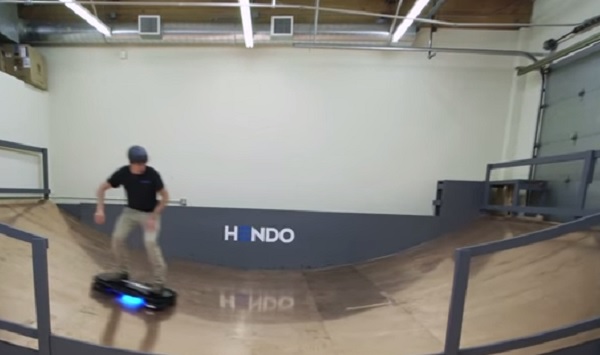
Great news for all those who have ever dreamt of owning a flying skateboard as featured in the sci-fi movie "Back to the Future". An American start-up company has finally found a way to develop a working prototype of a hoverboard, which can be bought for a price of $10,000.
The first real commercially marketed hoverboard, which uses magnetics to float is expected to hit the markets by December 2015 and the creators believe their technology will someday be used to carry large containers or even hold apartments and buildings in earthquake prone regions.
"You can very much tell that it's friction-less so you just smoothly move along, and it's odd because you can move in all directions," engineer Kyle O'Neil of Arx Pax told Associated Press.
Greg and Jill Henderson, co-founders of the firm, Arx Pax, which developed the Hendo Hoverboard now even want to open a theme park exclusively for flying hoverboards. "This is just the beginning of where this technology can go," said Greg Henderson.
"The wheel has served us very, very well, and we're not taking the wheel head on, but there are certain places where this may be more appropriate than the wheel," he added.
Since the 1989 cult sci-fi classic "Back to the Future" featured the flying skateboard, the public interest towards hoverboards has only increased over the years. In the "Back to the Future" trilogy Marty McFly used a flying skateboard to escape attackers, banking against bushes and petering out over a lake in one scene.
And this is what the creators of the flying hoverboard want to achieve in the long run. At present, the flying skateboards work only over metal surfaces, however, the company wants a final model that can fly over every surface, including water.
The American start-up company initially was looking at bringing in $2,50,000, however, it is reported he has been offered $4,37,000 - way more than what it had asked for.
While the consumers can buy the complete Hendo hoverboard at a starting price of $10,000, the Daily Mail reported that Arx Pax is now also looking at making the technology inside the device available to the public via its crowd funding site, Kickstarter.
Through the crowd-funding process, the company now wants to raise $2,50,000 for the campaign and would sell the technology marketed as the Hover Engine developer kit for $299.
"We want to see what you can do with our technology," the company writes on their Kickstarter page. "You can use it for hovering, or for applications we haven't even imagined."
What Makes Hoverboard Fly?
The magic behind the hoverboard lies in its four disc-shaped hover engines. These engines induce an opposing magnetic field on the surface below that provides lift, levitating the board off the ground.
While the hoverboard is primarily intended to be self-propelled, the actions that stabilise it can also be used to drive it forward by altering the projected force on the surface underneath it.
Currently, this surface substrate needs to be a non-ferromagnetic conductor.

















